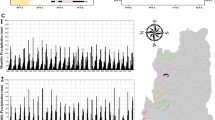Abstract
Himalayas possess one of the largest resources of snow, ice and glaciers that act as a huge freshwater reservoir. Monitoring the glaciers is important to assess the overall reservoir health of the Himalayas. Samudra Tapu is one of the largest glaciers in Chandra basin of district Lahaul and Spiti, Himachal Pradesh. Based on the field investigations and the remote sensing techniques. features such as accumulation area, ablation area snowline/equilibrium line, moraine-dammed lakes and permanent snowfields were mapped. The glacial terminus was identified using moraine-dammed lake, as lake is located at down streamside of the terminus. The total recession of glacier during the period of 38 years (1962–2000) is about 742 m with an average rate of 19.5 m/yr. In addition, glacial extent is reduced from 73 to 65 km2 between 1962 and 2000. suggesting overall deglaciation of 11%. During field investigation. three stages of glaciation using terminal moraine were identified. These moraines were mapped by merging LISS-II1 and PAN data. At the peak of glaciation. the glacial terminus was extended 3.18 km downstream of terminus position in year 2000. Total area during peak of glaciation period has been observed to be 77.67 km2, which is 12.67 km2 higher than the present glacier extent.
Similar content being viewed by others
References
Casassa, G., Smith, K., Rivera, A., Araos, J., Schnirch, M. and Schneider, C. (2002). Inventory of glaciers in isla Riesco, Patagonia, Chile, based on aerial photographs and satellite imagery.Annals of Glaciology,34: 373–378.
Denton, G.H. and Hughes, T.J. (1981). The last great ice sheets. John Wiley and Sons, New York, USA, pp. 7–10.
Dobhal, D.P., Gergan, J.T. and Thayyen, R.J. (2004). Recession and morphogeometrical changes of Dokriani glacier (1962–1995) Garhwal Himalaya, India.Current Science,86(5): 692–696.
Dobhal, D.P. and Surendar Kumar (1996). Inventory of Glacier Basins in Himachal Himalaya.J. Geological Society of India,48: 671 -681.
Flint, R.F. (1964). Glacial and Quaternary Geology. John Wiley and Sons Inc., pp. 63–85.
Hansen, J. and Lebedeff, S. (1987). Global trends of the measured surface air temperature.J. Geophysical Research,D(ll): 13345–13372.
Hansen, J.et al. (2005). Earth’s energy imbalance: confirmation and implications.Science,308(5727): 1431–1435.
IPCC (2001).Climate Changes 2001: The Scientific Basis. Contribution of Working Group I to the Third Assessment Report of the Intergovernmental Panel on Climate Change (Houghton, J.T, Y. Ding, D.J. Griggs. M. Noguer. P.J. van der Linden, X. Dai, K. Maskell and C.A. Johnson (eds) Cambridge University Press, Cambridge, United Kingdom and New York, NY, USA, 881 p.
Mikhalenko, V.N. (1997). Changes in Eurasian glaciations during the past century: glacier mass balance and ice-core evidence.Annals of Glaciology,24: 283–287.
Kaab, A., Frank Paul, Maisch, M., Hoelzle, M. and Haeberli, W. (2002). The remote-sensing-derived swiss glacier inventory: II First results.Annals of Glaciology,34: 362–366.
Kulkarni, A.V., Rathore, B.P., Mahajan, S. and Mathur, P. (2005). Alarming retreat of Parbati Glacier, Beas basin, Himachal Pradesh.Current Science,88(11): 1844–1850.
Kulkarni, A.V. and Alex, S. (2003). Estimation of recent glacial variations in Baspa Basin using Remote Sensing Techniques.J. of the Indian Society of Remote Sensing,31(2): 81–90.
Kulkarni, A.V. and Bahuguna, I.M. (2002). Glacial retreat in the Baspa Basin, Himalayas, monitored with satellite stereo data.J. of Glaciology,48(160): 171- 172.
Kulkarni, A.V., Mathur, P., Rathore, B.P., Alex, S., Thakur, N. and Manoj Kumar (2002). Effect of Global warming on snow ablation pattern in the Himalayas.Current Science,83(2): 120–123.
Kulkarni, A.V. and Buch, A.M. (1991). Glacier Atlas of Indian Himalaya. SAC/RSA/RSAG-MWRD/ SN/05/ 91, 62p.
Oberoi, L.K., Siddiqui, M.A. and Srivastava, D. (2001). Recession of Chipa, Meola and Jhulang (Kharsa) glaciers in Dhauliganga valley between 1912 and 2000. GSI Special Publication,11(65): 57–60.
Ruddiman, W.F. (2005). How did humans first alter global climate? Scientific American,292(3): 34–41.
Seiler, W. and Hahn, J. (2001). The natural and anthropogenic greenhouse effect-Changing Chemical composition of the atmosphere due to Human activities, in Climate of 21st century: changes and risks. Published by Wissenschaftliche Auswertungen, Berlin, Germany, pp. 116–122.
Author information
Authors and Affiliations
Corresponding author
About this article
Cite this article
Kulkarni, A.V., Dhar, S., Rathore, B.P. et al. Recession of samudra tapu glacier, chandra river basin, Himachal Pradesh. J Indian Soc Remote Sens 34, 39–46 (2006). https://doi.org/10.1007/BF02990745
Received:
Revised:
Issue Date:
DOI: https://doi.org/10.1007/BF02990745




